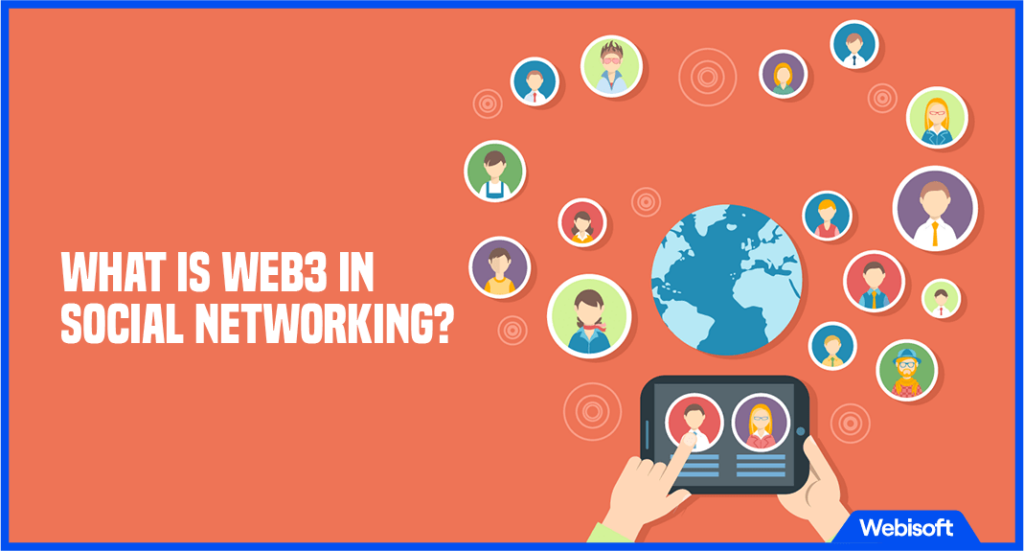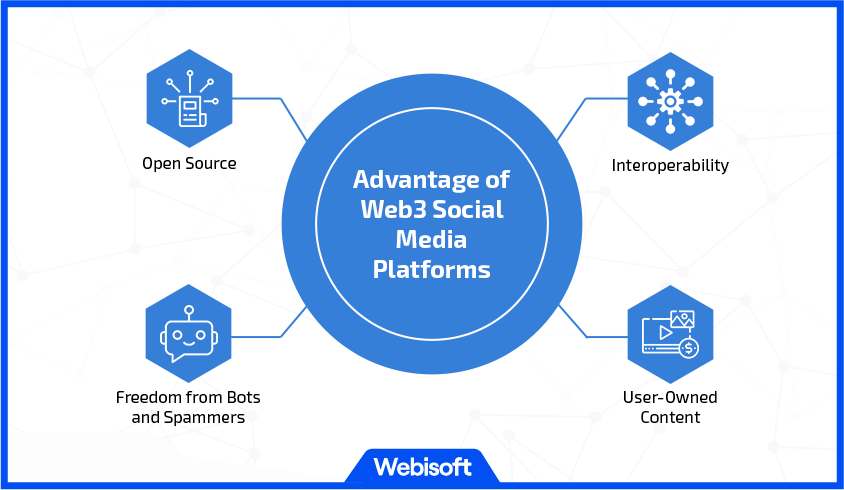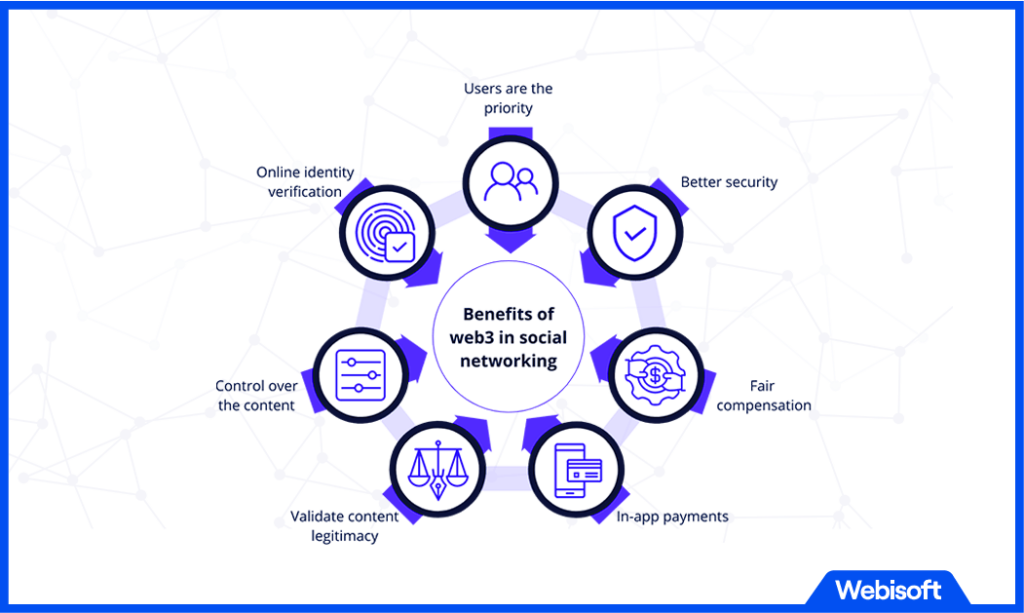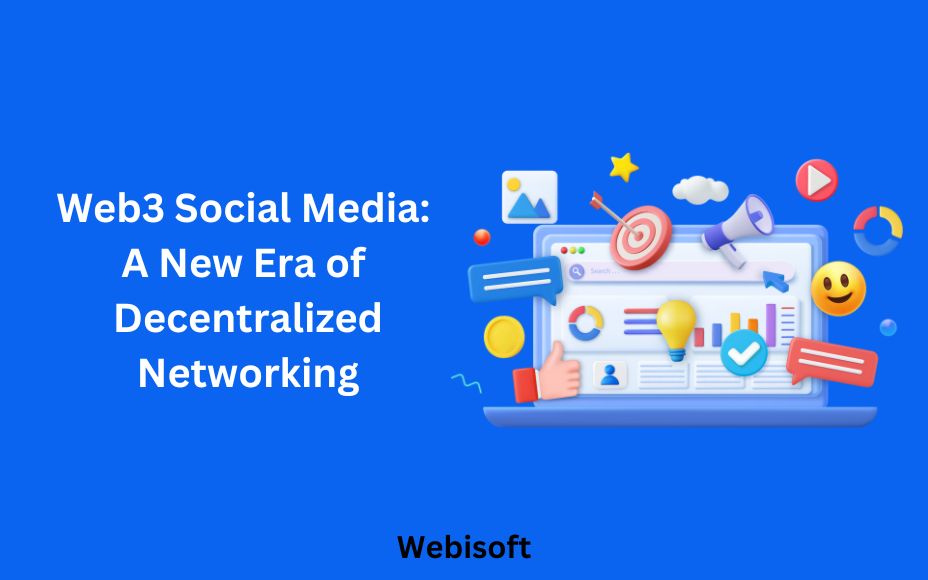Social media has become an integral part of our lives, connecting individuals across the globe. Platforms like Facebook and WhatsApp, built on the foundation of Web 2.0, have transformed communication and information sharing.
They have facilitated seamless connections with friends, family, and colleagues, enabling personal and professional interactions on a global scale. Nearly half the world’s population actively uses social media.
It has revolutionized building relationships, promoting businesses, and sharing experiences. However, this convenience has drawbacks.
Traditional social networks, governed by centralized control, are plagued by data breaches, censorship, and privacy infringements. The need for a more secure, transparent, and user-centric approach has led to the emergence of Web3 social media platforms.
This article will explore the advantages of Web3 in social networking and how it surpasses the limitations of traditional Web 2.0 social media platforms.
Contents
- 1 The Power of Web3 in Social Networking
- 2 What is Social Networking? How is It Different from Social Media?
- 3 What is Web3 in Social Networking?
- 4 How Do Web3 Social Networks Work?
- 5 The Advantage of Web3 Social Media Platforms
- 6 Benefits Of Web3 in Social Networking
- 7 Final Thoughts
- 8 Frequently Asked Questions
The Power of Web3 in Social Networking
1. Decentralized Control
Web3 social media platforms operate on decentralized networks, eliminating the need for a central authority that controls user data and content.
Users have ownership and control over their data, ensuring enhanced privacy and protection against unauthorized access or misuse.
2. Enhanced Privacy and Security
Web3 platforms employ blockchain technology, cryptographic protocols, and smart contracts to ensure data privacy, security, and integrity.
User information is stored decentralized, reducing the risk of large-scale data breaches and unauthorized data collection.
3. User Empowerment
Web3 social media platforms empower users by allowing them to participate in content governance and decision-making processes.
Users have control over their content’s visibility, sharing, and monetization, fostering a more inclusive and democratic social network.
4. Monetization Opportunities
Web3 platforms enable users to directly monetize their content and interactions through mechanisms like tokenization, micropayments, and decentralized finance (DeFi) integrations.
Content creators can receive fair compensation for their contributions, creating new avenues for revenue generation and fostering a sustainable creator economy.
5. Immutable and Transparent Recordkeeping
Web3 platforms leverage blockchain technology to create an immutable and transparent record of user interactions, content history, and transactional data.
This fosters trust and accountability within the social network ecosystem, as all actions are verifiable and traceable.
Web3 social networking can revolutionize connecting, communicating, and sharing digitally. These platforms prioritize user autonomy, data privacy, and fair value distribution, addressing the shortcomings of traditional Web 2.0 social media platforms.
As the world embraces the benefits of Web3, we can look forward to a more user-centric, secure, and inclusive social networking experience.
What is Social Networking? How is It Different from Social Media?
While “social media” and “social networking” are often used interchangeably, they have distinct meanings. Social networking refers to the act of building interactive relationships through online platforms.
Social media serves as the vehicle for this networking. Let’s delve deeper into the difference between social networking and social media.
Social Networking: Building Interactive Relationships
Social networking involves establishing connections and fostering relationships with various individuals, including friends, family members, colleagues, customers, and more.
It involves the creation of a network where people can interact, share experiences, and engage in meaningful conversations. Social networking platforms provide a space for users to connect with others who share common interests, goals, or professional affiliations.
Social Media: Enabling Networking through Digital Platforms
Social media platforms, like Facebook, Instagram, Twitter, LinkedIn, and others, act as a medium for social networking.
These platforms provide users tools and features to connect, communicate, and share content with their network. They enable users to post updates, photos, videos, and other forms of media, as well as engage in discussions, comments, and likes.
Distinguishing Factors:
1. Purpose
Social networking is centered around building and nurturing relationships within a network of individuals.
Social media platforms serve as the means to facilitate these interactions and enable networking opportunities.
2. Platforms
Social networking can occur online and offline, including social media platforms, professional networking sites, interest-based forums, and more.
Social media platforms, specifically Web 2.0 platforms, are the most common digital spaces where social networking occurs.
3. Interaction
Social networking emphasizes meaningful interactions and relationship-building, focusing on connecting with others personally or professionally.
Social media platforms provide the tools and features for users to engage in interactions, share content, and participate in online communities.
4. Accessibility
Social networking can extend beyond the boundaries of social media platforms, encompassing in-person networking events, conferences, industry gatherings, and other offline interactions.
Social media platforms offer accessible and user-friendly digital interfaces. It can be accessed via web-based applications or dedicated software on computers, smartphones, and tablets.
While social media and social networking are closely intertwined, they represent distinct aspects of online interaction. Social networking revolves around building relationships and fostering connections within a network.
These platforms serve as the medium through which these interactions occur. Understanding social networking and social media differences helps us appreciate the multifaceted nature of online communication and the various platforms.
What is Web3 in Social Networking?

Web 2.0 social networking is centralized and poses privacy concerns for users and their data. Tech giants completely control user information, and content creators have no authority over their work.
Web3, a new paradigm in social networking, aims to establish a decentralized ecosystem where users have control over their data.
Current platforms generate considerable revenue from users who scroll through feeds, watch videos, or read blogs.
However, most users see no financial returns. Web3 seeks to change this by incentivizing users for their contributions.
How Do Web3 Social Networks Work?
Web3 social networks rely on blockchain technology, a transparent digital ledger storing immutable data. As decentralized applications (dApps), Web3 social networks aren’t reliant on a single point of failure.
These dApps use smart contracts as a backend, defining the application’s business logic. The dApp ecosystem spans a global peer-to-peer network with thousands of nodes. This structure ensures continued performance even if some nodes fail.
Various blockchain-powered Web3 platforms reward both creators and consumers. These platforms each have native tokens that benefit users rather than a select few.
The Advantage of Web3 Social Media Platforms

Web3 social networking offers a transformative approach to online interaction, making it a superior choice to Web 2.0. Here’s how:
1. Open Source
A key feature of Web3 lies in its open-source nature, where data lives in an open, decentralized blockchain devoid of gatekeepers who can obstruct your access.
This unprecedented level of freedom paves the way for developers to replicate functionalities independently without the constraint of other protocols.
In practical terms, developers can fork any social media platform’s codebase. Subsequently, they can create an improved version enriched with superior features and an enhanced user experience.
Think of it as taking the blueprint of an existing building and being able to build upon it, creating a structure that better fits your unique needs.
2. Interoperability
Web3 aims to revolutionize the digital space by promoting complete interoperability and fostering a fluid and efficient interaction platform.
This distinctive feature empowers users to seamlessly share content, data, and assets across social media platforms, encouraging better collaboration and community building.
Imagine sharing a thought-provoking article, an intriguing blog post, or even a whimsical meme across various platforms, all with a single click. Such is the potential offered by the interoperability of Web3.
3. Freedom from Bots and Spammers
One of the defining aspects of Web3’s superior approach lies in its robust blockchain technology, which verifies identities and data directly.
This crucial safeguard significantly enhances the safety of the online environment. It provides users with a secure platform free from the menacing presence of bots and spammers.
With Web3, you can interact and share content knowing that you deal with genuine users, not automated accounts. The peace of mind this provides is vital to the Web3 advantage.
4. User-Owned Content
Web3 social media platforms stand as a beacon for content creators by restoring the rightful ownership of their work.
Unlike Web 2.0 platforms, where your content can be removed at any moment without your consent, Web3 ensures that only you have control over your content.
This fundamental shift in power dynamics guarantees that you are the master of your content. From the moment of creation to the distribution decision, the power lies in your hands.
Benefits Of Web3 in Social Networking

Web3 can eliminate many of the issues associated with traditional social networking. It promises a paradigm shift in how users are viewed and treated.
Many existing social media platforms exploit users’ trust by selling their data to advertisers. Web3 puts an end to this practice by prioritizing user safety and privacy. It replaced centralized overseers with decentralized nodes and distributed data storage networks.
Web3’s social networking approach could redefine online interaction and sharing dynamics. It establishes a new order that favours user privacy and control.
1. Better Security
Social media platforms have been heavily scrutinized in this digital age for data collection practices. Every registration, post, group followed, and likes given are meticulously recorded, shaping a user’s social graph.
Unfortunately, this information is stored on centralized servers, which are not impervious to cyber threats. Cybercriminals, exploiting these vulnerabilities, have frequently stolen personal data to be sold to third-party advertisers.
The Cambridge Analytica scandal, infamous for misusing Facebook user data during elections, is a stark example of this vulnerability.
Yet, there are no definitive proofs regarding allegations of phone calls and messages being tapped. Users often grant permissions to apps to access their phones.
Enter Web3 – a possible solution to these problems. It doesn’t eliminate all of Web 2.0’s issues but significantly enhances security against data breaches and cyberattacks. Web3-based solutions are being designed specifically to address data vulnerabilities.
Owing to blockchain technology, the data is immutable, and unauthorized access is made tough through data encryption, enhancing data security.
2. User-Driven Content Control
Traditional social media platforms exercise control over the users’ social graphs. These platforms sometimes track users’ activities, including likes, comments, friend lists, groups followed, and even messages.
These insights tailor a personalized user experience, keeping users glued to the platform. Unfortunately, as users, you agree to surrender ownership of your data and social graph when accepting a platform’s “Privacy Policy” and “User Service Agreement”.
This means you also allow the platform to delete any of your content or even your account. Web3 flips the power dynamics, returning control of data and content to users.
In the Web3 realm, you own your content and social graph. Access and benefits can be granted only by you.
3. Incorporating In-App Payments
Traditional social platforms like Twitter, Facebook, Instagram, and WhatsApp have introduced in-app payment features to enhance user experience.
However, given the history of data scandals and security breaches, users naturally hesitate to enter their financial details into these platforms. Contrastingly, Web3, initially introduced for cryptocurrency transactions, offers a reliable solution for in-app payments.
Leveraging blockchain technology, it ensures maximum protection and user-friendly interactions. Smart contracts facilitate peer-to-peer payments, removing the need for a third party.
4. Authentication Of Content
With the internet swamped with false news and dubious content, the credibility of social media posts often comes into question. According to data from the Center Statistics Office (CSO), 62% of online information is untrustworthy.
Web3 brings a unique solution to this problem. Some Web3 platforms employ blockchain-based algorithms to verify the legitimacy of user-generated content and videos.
Though imperfect, this approach has proven effective in mitigating the proliferation of unreliable content. Moreover, blockchain-linked payments can incentivize users to rank content authenticity.
5. Equitable Compensation for Influencers and Popular Content
Web 2.0 platforms like YouTube, Facebook, Snapchat, and TikTok remunerate popular influencers based on their content’s engagement.
However, these platforms limit monetization opportunities, and often, the follower counts may not be genuine due to the use of bot accounts. Web3 social media platforms prioritize user interactions over follower count.
Blockchain ledgers track these interactions, providing more accurate metrics for equitable compensation. Smart contracts can initiate automatic payments for influencers based on these metrics.
6. Online Identity Verification
Social media platforms today are infested with fake accounts and bots, which are used for disseminating fake news, scams, and inappropriate content. Even distinguishing genuine accounts from bot-operated ones has become challenging.
Web3 offers a viable solution by implementing identity authentication techniques. Your details are stored on a blockchain, allowing Web3 services or social media platforms to cross-verify your information and confirm your authenticity.
Final Thoughts
Web3 in social networking heralds a new era of decentralized control, wrestling power from the tech giants and returning it to the users. With Web3, users regain control and ownership of their data, transforming from mere products to active contributors.
By integrating elements like digital ledger, NFTs, cryptocurrencies, and the Metaverse, Web3 broadens opportunities for content creators and users alike. Thus it expands the boundaries of social media.
If you want professional development services for tokens, Webisoft is the ideal choice. The company’s expert developers are proficient in creating various tokens.
Frequently Asked Questions
What Is Web3 Social Media?
Web3 social media refers to a new generation of platforms built on decentralized technologies, particularly blockchain.
Unlike traditional social media platforms, Web3 social media aims to give users more control over their data, enhanced privacy, and the ability to participate in decision-making processes.
It leverages blockchain’s transparency and security to enable peer-to-peer interactions, incentivized content creation, and tokenized economies.
How Does Web3 Social Media Differ From Traditional Social Media?
Web3 social media differs from traditional social media in several ways. Firstly, it operates on decentralized platforms, such as blockchain networks, where data is stored across multiple nodes.
Secondly, Web3 social media allows users to own and control their data, allowing them to decide how it is shared or monetized. Additionally, Web3 social media often incorporates decentralized governance mechanisms.
What Are the Benefits Of Using Web3 Social Media?
Using Web3 social media offers several benefits. Enhanced privacy and data ownership are significant advantages, as users have more control over their personal information and can avoid excessive data tracking and targeted advertising.
Web3 social media platforms foster a more transparent and trust-based environment, as content and interactions are often recorded on the blockchain. It reduces the risk of manipulation or censorship.
Furthermore, Web3 social media platforms allow users to earn tokens or rewards for their contributions and engagement.
How Does Web3 Social Media Promote User Empowerment?
Web3 social media promotes user empowerment by giving individuals greater control over their online presence. Users have ownership of their data, can choose how it is shared, and may even receive compensation for providing access to their information or engaging with the platform.
What Are Some Examples of Web3 Social Media Platforms?
Several Web3 social media platforms have emerged in recent years. Examples include:
a) Steemit: A blockchain-based platform where users can create and curate content, earning cryptocurrency rewards based on the popularity of their contributions.
b) Mastodon: A decentralized microblogging platform that allows users to host their communities (instances) while being part of a wider interconnected network.
c) Peepeth: A social media platform built on the Ethereum blockchain, focusing on censorship resistance, data ownership, and rewarding positive contributions with tokens.
d) Minds: An open-source social media network that incorporates blockchain technology to offer users privacy, control over their data, and the ability to earn tokens for engagement.
These platforms represent a few diverse Web3 social media platforms, each with unique features and focus.
